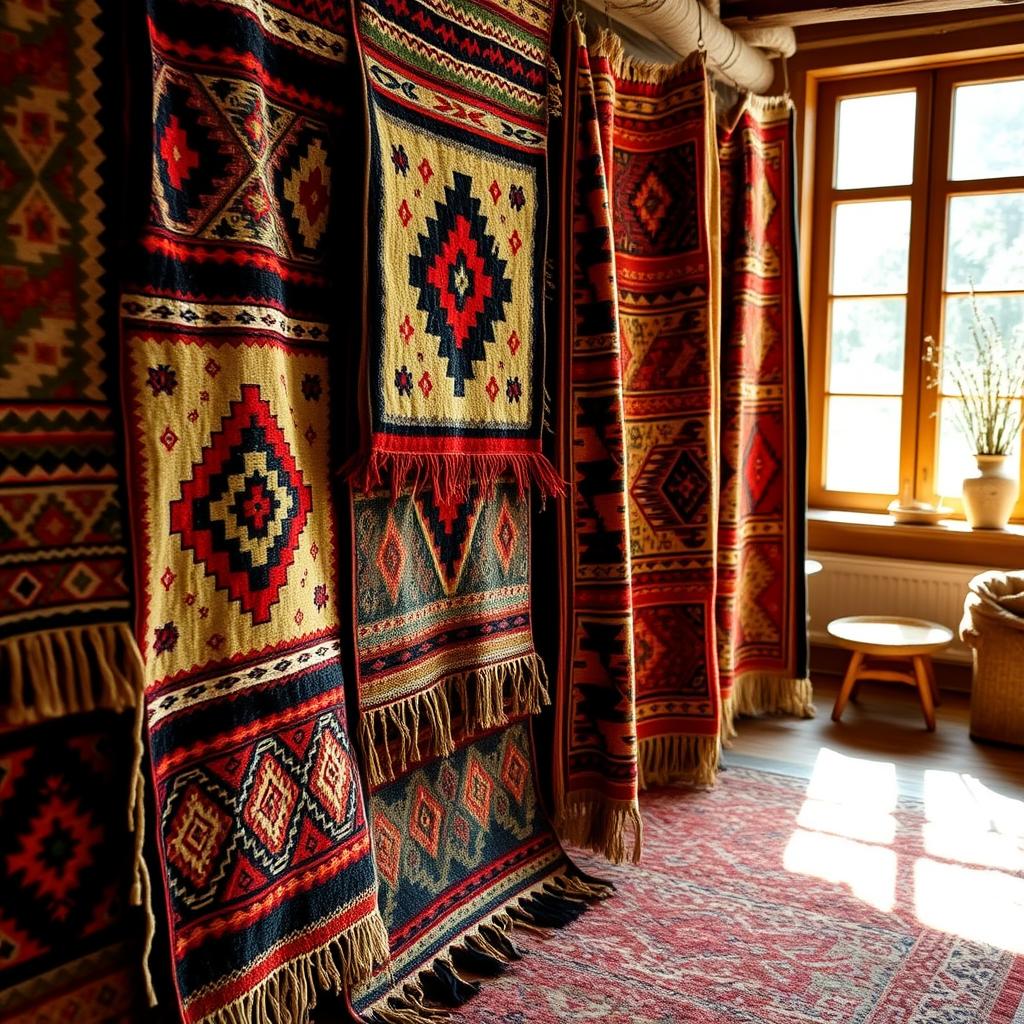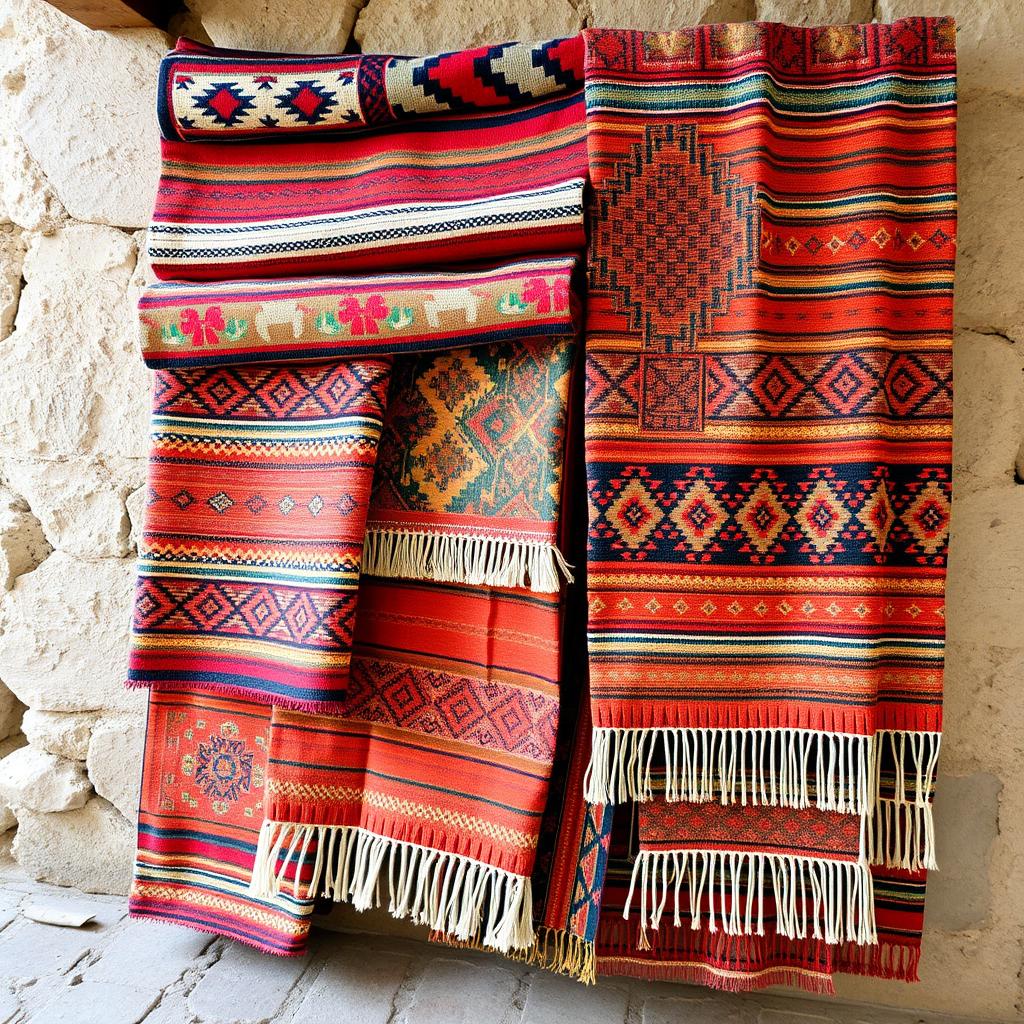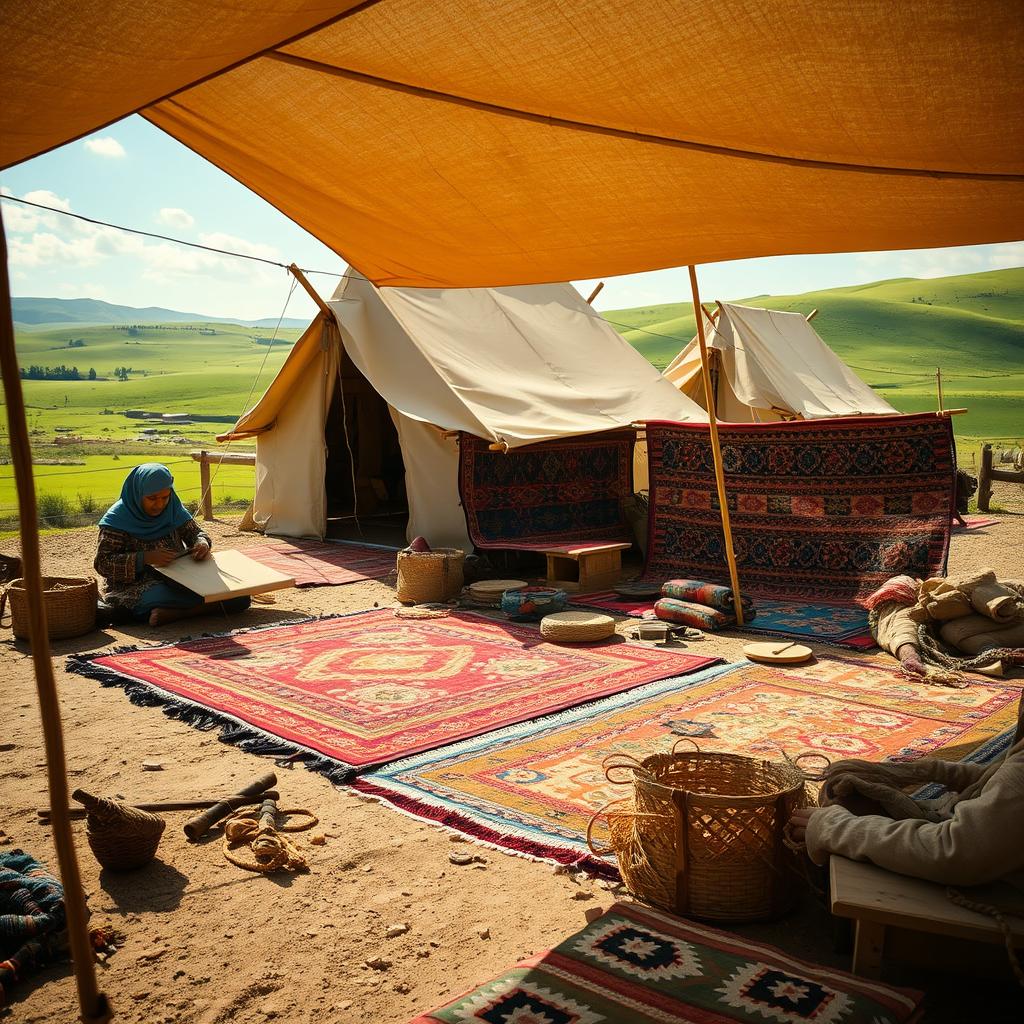Kilim and Kelim are terms for the same traditional flat-woven textile, known as Oriental rugs. These carpets have a rich history and are loved for their detailed designs and bright colors. They come from Anatolia and Central Asia, famous for their special weaving methods and the stories they tell.
Click to use Silverigroup personal shopper services
Key Takeaways:
- Kilim and Kelim are interchangeable terms for the same type of traditional flat-woven Oriental rug.
- These rugs have a long and storied history, originating in Anatolia and Central Asia.
- Kilim rugs are known for their intricate designs, vibrant colors, and unique weaving techniques.
- The symbolism and cultural significance of Kilim patterns are deeply rooted in the traditions of the regions where they were produced.
- Kilim rugs have become highly sought-after for their artistry and versatility in interior design.
Understanding Kilim: Origins and Etymology of Traditional Flatweaves
Kilim rugs have a long history, starting in ancient Anatolia and Central Asia. These flatweaves are key to traditional nomadic and tribal cultures. They show the beauty and importance of anatolian kilims and tribal patterns.
Ancient Origins in Anatolia and Central Asia
The history of Kilim rugs begins with the nomadic people of Anatolia and Central Asia. These skilled weavers, often women, made anatolian kilims. They used simple yet effective techniques to create strong and beautiful textiles.
Click to buy antique rugs from Silverigroup
Etymology and Regional Name Variations
The word “Kilim” comes from Turkic languages, with different spellings and pronunciations. The term “Kilim” or “Kelim” comes from the Persian word “Gilim,” meaning a flat-woven textile. This shows the shared heritage and cultural exchange in Kilim history.
Cultural Significance Across Different Regions
Kilim rugs are more than just floor coverings. They are symbols of identity, storytelling, and spiritual beliefs. The tribal patterns in Kilims tell stories of the communities that made them. The legacy of Kilim weaving is still loved by many today. It shows the artistic heritage and strength of nomadic and tribal cultures.

Traditional Weaving Techniques of Kilim Rugs
The art of making wool kilims comes from ancient traditions. These traditions have been passed down through generations of nomadic weavers. Kilim rugs are special because of their unique weaving method.
The core of traditional kilim weaving is its flatweave structure. This is made by weaving the warp and weft threads together without a pile. This creates a flat, tapestry-like surface with striking geometric designs. The weavers pick and prepare the natural wool fibers and dye them with colors from local plants and minerals.
The tools and methods used in kilim making have stayed the same for centuries. Weavers use a simple wooden loom to weave the threads. They create intricate patterns and motifs that show the cultural heritage of their regions.
- Warp threads are tightly stretched on the loom, providing the foundation for the weave.
- Weft threads are then woven through the warp, creating the distinctive flatweave structure.
- Skilled weavers use a wooden beater to compact the weft threads, ensuring a sturdy and cohesive textile.
The end result is a durable and stunning kilim rug. It’s filled with the stories and traditions of the people who made it. These wool kilims are loved by collectors and enthusiasts worldwide. They remind us of the lasting impact of traditional weaving techniques.

The Distinctive Characteristics of Kilim Textiles
Kilim textiles stand out for their special materials, bright colors, and detailed symbols. Knowing these traits helps us see the deep cultural value and skill in these traditional flatweaves.
Material Composition and Structure
Kilims are made from top-quality wool from hardy sheep in Anatolia and Central Asia. This wool is loved for its shine and lasting quality. Kilims have a special flat and reversible design, thanks to their weft-faced plain weave structure.
Color Palettes and Natural Dyes
The colors in kilim designs mirror the natural world. Bright reds, blues, and yellows come from natural dyes like madder root, indigo, and saffron. These dyes add depth and richness, showing the textiles’ cultural roots.
Common Motifs and Their Meanings
- Geometric patterns: Triangles, diamonds, and zig-zags show the natural world or spiritual beliefs of the weavers.
- Stylized animals: Animals like horses, camels, and birds symbolize the nomadic life and the weavers’ bond with nature.
- Symbolic designs: Symbols like the “tree of life” or the “evil eye” carry deep cultural meanings, reflecting the weavers’ traditions.
Kilim textiles are special because of their materials, colors, and symbols. They are a unique and fascinating art form that draws in fans of tribal patterns, wool kilims, and vintage kilim rugs.

What is the meaning of Kilim or Kelim?
The terms “Kilim” and “Kelim” both refer to the same type of flat-woven textile. This style is known as an Oriental rug. The spelling and pronunciation can change based on where you are and the language spoken.
For example, Ziegler Oriental carpets were once called “Chobi” carpets. Western traders later introduced the name “Ziegler.” Similarly, “Kilim” and “Kelim” are used to describe these traditional flat-woven textiles. They have been made using traditional weaving techniques for centuries. The origins of these terms come from Anatolia and Central Asia. The art of Kilim weaving has deep cultural roots there. The word “Kilim” comes from Turkish and Persian languages. “Kelim” is more common in the Caucasus region and parts of the Middle East.
“Kilim and Kelim are not just words, but a testament to the rich cultural heritage and artistic traditions of the regions where these remarkable textiles were created.”
Despite regional differences, Kilims and Kelims are known as flat-woven textiles. They are valued for their unique designs, vibrant colors, and the skill of the weavers. These weavers have perfected their craft over generations.

The Historical Journey of Nomadic Carpet Making
The art of making nomadic carpets, also known as antique Turkish kilims, comes from the traditions of nomadic tribes. These tribal patterns show the rich culture and resilience of nomadic life over centuries.
Tribal Traditions and Techniques
The nomadic carpets and antique Turkish kilims come from generations of nomadic weavers. These artisans, often women, used simple looms and natural dyes. They created vibrant, geometric designs with deep symbolic meanings. The weaving was a family or tribe effort. Families worked together to make these masterpieces. The patterns were inspired by nature, showing their connection to the environment.
Evolution Through Centuries
As nomadic tribes moved, their nomadic carpets and antique Turkish kilims changed. They adapted to new environments and cultural influences. Designs and techniques became more portable and durable. Over time, tribal patterns were influenced by new materials and dyes. Even sedentary weaving traditions were added. This mix of ideas has made these textiles rich and lasting. Today, antique Turkish kilims and nomadic carpets amaze collectors and designers. They show the spirit and artistry of nomadic peoples.

Tribal Patterns and Symbolism in Kilim Design
Kilim rugs are more than just decorations. They carry the stories and traditions of many cultures. The designs in Anatolian kilims show the deep heritage and beliefs of the tribes that made them. At the core of kilim design is a rich symbolism. Each pattern has its own meaning, tied to the lives and customs of the nomadic tribes. The designs range from natural shapes to abstract patterns that speak of spiritual beliefs.
Anatolian kilims are known for their tribal patterns. These patterns reflect the culture and traditions of the weaving communities. They often include shapes like diamonds and triangles, seen as symbols of fertility and protection. The symbols in kilim patterns offer a glimpse into the worldview of the nomadic tribes. For example, the “eye” motif is thought to ward off evil spirits. The “tree of life” pattern connects the earthly and spiritual worlds.
Understanding the symbolism and cultural value of kilim design helps us appreciate their artistry. The tribal patterns and motifs of Anatolian kilims show the lasting power of tradition and the beauty of handmade textiles.
Different Types of Anatolian Kilims and Their Features
Anatolian kilims are a unique part of the world of oriental rugs. They come from the Anatolian region of Turkey. This area is known for its rich history and many different types of kilims.
Regional Variations
Anatolian kilims show the different cultures and places they come from. The Sivas kilims have detailed geometric patterns. The Konya kilims are known for their bright and bold designs. These designs tell us about the artistic traditions of Anatolia. They show the diversity of rug-weaving in the region.
Design Elements
Anatolian kilims have designs that are full of meaning and beauty. You’ll see floral patterns, geometric shapes, and symbols of nature. These designs are not just pretty; they carry deep cultural and spiritual messages.
Construction Methods
The wool kilims from Anatolia are famous for their quality and durability. This is thanks to the skilled weaving techniques used. The kilims are made using a tapestry method, which makes them strong and long-lasting. Anatolian kilims are a treasure trove of culture, art, and beauty. They are highly valued in the world of oriental carpets and textiles.

Collecting and Caring for Vintage Kilim Rugs
Collecting vintage kilim rugs and antique Turkish kilims is exciting. It’s important to know their history and value. This helps in finding, buying, and keeping these special textiles. The terms kilim and kelim are often used the same way. They both mean a traditional flatweave rug. The different spellings come from local languages and traditions, similar to how Ziegler carpets were once called Chobi in the West.
Identifying Authentic Vintage Kilim Rugs
Finding out if a vintage kilim rug is real takes skill and knowledge. Look for:
- Unique weaving styles and patterns from certain areas
- Natural dyes and materials used
- Wear and tear that shows age and use
- Reliable sellers and dealers
Caring for Antique Turkish Kilims
Keeping these textiles beautiful and lasting needs careful steps. Right storage, soft cleaning, and smart display help. These actions help vintage kilim rugs last longer.
| Preservation Tip | Explanation |
|---|---|
| Avoid direct sunlight | UV rays can fade and harm them over time. |
| Use gentle cleaning methods | Stay away from strong chemicals and machine wash. Choose professional cleaning or hand-wash gently. |
| Proper storage conditions | Keep them in a cool, dry spot. This keeps them safe from moisture and pests. |
Knowing the history and importance of kilim or kelim textiles helps collectors. They can then buy and care for these pieces responsibly. This way, they ensure these artworks are kept safe for future generations.
Modern Applications and Contemporary Kilim Designs
Kilims, known for their timeless beauty, have moved beyond traditional rugs. They now play a key role in modern interior design. The charm of tribal patterns and the cultural heritage of kilim weaving are being reimagined for today’s tastes and lifestyles.
Interior Design Applications
Kilim-inspired designs are all the rage in interior decor. They can be found on throw pillows, wall hangings, furniture, and even drapery. Their bold, geometric patterns and bright colors bring a unique ethnic touch to any room, whether it’s cozy or modern.
Modern Interpretations of Traditional Patterns
Today’s designers are mixing kilim patterns with new materials and methods. This creates innovative designs that are both stylish and meaningful. These modern kilim pieces bring the essence of what is the meaning of kilim or kelim into our homes. The adaptability of flat-woven textiles makes them perfect for modern spaces. They fit right in with boho-chic rooms and minimalist offices. As people seek out unique, culturally-inspired decor, tribal patterns in kilim designs will likely become even more popular.
Conclusion
The world of Kilim or Kelim textiles is fascinating. It shows the rich culture and art of ancient times. These flat-woven pieces come from the Anatolian region and Central Asia. They have lasted for centuries, showing the traditions and symbols of nomadic tribes. These textiles are not just beautiful. They also have deep meanings. We’ve looked at what makes them special and why they’re loved by many.
Kilim rugs add color and beauty to homes. They are also valuable keepsakes. The mix of old weaving methods and new designs makes them popular today. Exploring Kilim rugs, we see their lasting beauty and the stories they tell. They show the art and culture of the past. This makes them even more special.
We now understand more about Kilim or Kelim. We know about their weaving techniques and lasting impact. By celebrating their history and variety, we keep their beauty alive for future generations.
FAQ: What is the meaning of Kilim or Kelim?
What is the meaning of Kilim or Kelim?
Kilim or Kelim is a type of flat-woven textile from Anatolia and Central Asia. These rugs and carpets are rich in culture, with intricate designs and natural dyes.
What are the origins and etymology of Kilim or Kelim?
Kilim or Kelim comes from ancient Anatolia and Central Asia. It has many names, showing the cultural diversity of these textiles.
What are the traditional weaving techniques used to create Kilim rugs?
Kilim rugs use a flat-weave technique. This method, passed down through generations, makes the rugs durable and unique.
What are the distinctive characteristics of Kilim textiles?
Kilim textiles are made from wool and have vibrant colors from natural dyes. They feature common motifs with deep symbolic meanings.
How have Kilim designs and techniques evolved over time?
Kilim-making has a rich history. Techniques and designs have changed, influenced by nomadic tribes and communities. These textiles have kept their cultural essence while evolving.
What is the significance of tribal patterns and symbolism in Kilim design?
Kilim patterns reflect the cultural beliefs and traditions of the tribes. These designs hold deep meaning and artistic value.
What are the different types of Anatolian Kilims and their features?
Anatolian Kilims vary by region, each with its own design and construction. These differences make each Kilim unique.
How can one collect and care for vintage Kilim rugs?
To collect and care for vintage Kilim rugs, you need to know how to authenticate and preserve them. Proper care ensures their longevity.
How are Kilim designs being adapted for modern applications?
Kilim designs are now used in modern interior design and products. They blend traditional patterns with modern styles.

